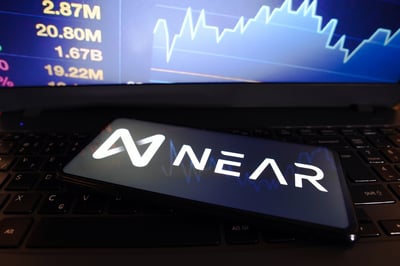It can be argued that blockchain has already gone mainstream, at least regarding its visibility. The incredible price gains of some cryptocurrencies, the volatility of these digital assets, and the numerous scams and exchange crashes have all generated tons of publicity, so much so that few people aren't aware of crypto.
And yet, in terms of actual adoption, crypto remains a niche technology, with a global adoption rate that stands at 4.2%, according to data from Triple-A.
Digital ownership and tokenized assets promise to revolutionize finance and provide access to saving and investment opportunities that simply didn't exist before the birth of blockchain, but this is just the tip of the iceberg regarding its potential. The biggest promise is the idea of Web3, which is a new kind of internet that will consist of thousands of decentralized applications that give power and privacy back to their users, creating a digital society that, by design, is more inclusive.
The potential of crypto is there for all to see, but that alone is not enough to convince everyone to embrace it. If crypto is to achieve mainstream adoption, it needs to deliver more than just the minor benefits it affords users today. Instead, it must become as simple to use and as intuitive as traditional social media, so its target audience can use it effortlessly.
What's required then is a more user-friendly environment for crypto, with platforms and services that offer a familiar UI and experience and can seamlessly interact with one another -- as well as the worlds of Web2 and traditional finance.
Challenges & Solutions
1. Usability
Anyone who's ever had to show their grandmother or grandfather how to send an email or sign up to Facebook will understand just how difficult it can be to break down technological barriers. And this is a big stumbling block on crypto's road to mainstream adoption.
While it might be easy for crypto natives to jot down a seed phrase and keep it somewhere safe, the same cannot be said for the masses. The vast majority of people in the world want a simple and convenient user experience, and they don't want to take on big responsibilities. Perhaps most importantly, they need a way to protect themselves against complacency, as people forgetting passwords is an incredibly common thing. But if forgetting a password means losing all your savings forever, few people are going to want to touch crypto. The fact is, most people opt for convenience over security. They choose simple passwords that are easy to remember -- and easy to hack -- and they want to sign up for every new service in the easiest way possible, such as with a social media account.
The good news for crypto is that the industry has come to recognize this challenge and is doing something about it. That explains the emergence of easier-to-use crypto wallets such as Zengo, which uses multi-party computation (MPC) technology to secure the user’s account, and Ryder, which uses a novel social recovery technique to help users recover their wallet in the event they lose their password.
2. Education
Someone who's reading up on blockchain for the first time will probably be intrigued to learn that it is immutable, only to be surprised when they delve into a different article and discover that it's actually not impossible for it to be changed. Similarly, new users will likely have heard that crypto supports anonymous transactions, only to read more and learn that their transactions can actually be traced. These are just some of the challenges involved in educating new users about crypto.
The fact is, crypto isn't a simple thing and the vast majority of people won't even bother to read up on it. But for crypto to become commonplace, people need to know the difference between Bitcoin and a utility token or governance coin. They need to understand that an NFT isn't cryptocurrency, and they will likely need to grasp the importance of using a non-custodial wallet to protect their funds.
Education is a big challenge for the crypto community, but it's one that can be solved through gamification.
Gamification is exactly as it sounds. It involves educating people through fun and enjoyable games, and there are numerous ways in which we can do this. For instance, the space exploration and mining game LandRocker introduces DeFi concepts into its gameplay, teaching people how to "stake" crypto to obtain essential resources they need to win the game. Then there's Banksters, which is an NFT-based crypto trading simulator that gamifies the trading experience to teach players how to trade profitably. The game is based on real-life crypto market movements and instructs players on how to deal with the volatility of different tokens, while improving their financial literacy.
We might also consider Yellow Duckies, an NFT trading game built atop of the Layer-3 platform Yellow Network, which acts as a testing ground for new features before they're deployed on the main network. Yellow Duckies uses rewards to incentivize users to test out the network's new capabilities and iron out any kinks, while simultaneously teaching them how to use Yellow to trade tokens across different blockchains.
3. Sustainability
Sustainability is another major concern that prevents many users from diving headlong into crypto. With all of the headlines about how much of an energy hog the Bitcoin network is, it's no surprise that a significant number of people don't want to go anywhere near it.
The younger generation especially is extremely conscious of sustainability issues, and so long as reports persist around the environmental damage caused by Bitcoin, crypto will remain a tough sell.
Fortunately this is another area where the industry is working to overcome such barriers. Innovations involving alternative consensus mechanisms mean that many blockchains are now incredibly eco-friendly. Ethereum, for instance, the world's biggest smart contract blockchain, recently switched from an energy-hungry proof-of-work consensus algorithm to proof-of-stake, which eliminates the need for miners to perform intensive computations to process transactions. There are plenty of other proof-of-stake networks competing with Ethereum too, such as Tezos, Polkadot, Solana, Avalanche and Cardano.
Elsewhere, we are seeing countries such as Canada and Iceland embracing mining operations with the use of sustainable energy resources, such as geothermal power., ensuring that blockchain does no harm to the environment.
4. On-Ramps
On-ramps are the term used to describe the process in which people can use fiat currency to buy cryptocurrency. They're essential, of course, because everyone needs to start their crypto journey somewhere and that invariably involves purchasing digital assets using their regular savings.
The problem is, how? Traditionally, most people visit a crypto exchange, but while many such platforms are considered to be user-friendly, it's still a convoluted process. Users must sign up to the exchange, provide ID to pass the KYC checks, and then buy the actual token they want, before transferring it into their own wallet.
This is a big obstacle for onboarding news users into Web3. Someone who's interested in playing a blockchain game, for instance, may find they need to acquire an NFT, and to do that they must pay in crypto. But if that person knows next-to-nothing about crypto, are they really going to go through all of that hassle? It will need to be a hell of a good game for them to do so.
Enter Ramp Network with the solution. Ramp is a provider of crypto on-ramps, and it not only has its own application that enables the swift purchase and sale of crypto assets, but more importantly, it has created an API that allows developers to embed the same capabilities into their apps. So that blockchain game can now make it simple for users to buy the NFT or crypto they need, directly from within the game, using familiar payment methods such as a bank transfer, credit or debit card. Users can get started with a few simple clicks, and they can also sell whatever crypto they earn from the game and receive fiat in return.
By enabling developers to offer simple on- and off-ramps into and out of crypto, Ramp appears to have cracked what is one of the biggest onboarding challenges of all.
All Aboard The Crypto Train
There are good reasons to want to try and onboard the entire world into crypto and Web3, for the potential benefits could well be life-changing for millions. With crypto, the financial ecosystem becomes vastly more accessible, enabling everyone to become their own bank and access various kinds of services, including savings, loans, borrowing and investments, without any hassle or middleman involved.
For businesses the benefits are just as convincing, for blockchain and crypto can automate and simplify many complex processes with smart contracts, reducing their costs and improving efficiencies. Moreover, crypto offers unique opportunities for fundraising via concepts such as ICOs and token sales, providing entrepreneurs with a different path to grow their business and enhance customer trust.
By paving the way to Web3, the crypto industry can help to create a much more inclusive financial system, with innovative business solutions and opportunities for everyone to grow their wealth. As the industry matures and stakeholders collaborate to overcome the barriers around usability, education and on-ramps, the world will slowly but surely come to understand the advantages of decentralized money, and how it can transform everybody's lives for the better.
 Nikolas Sargeant
Nikolas Sargeant





